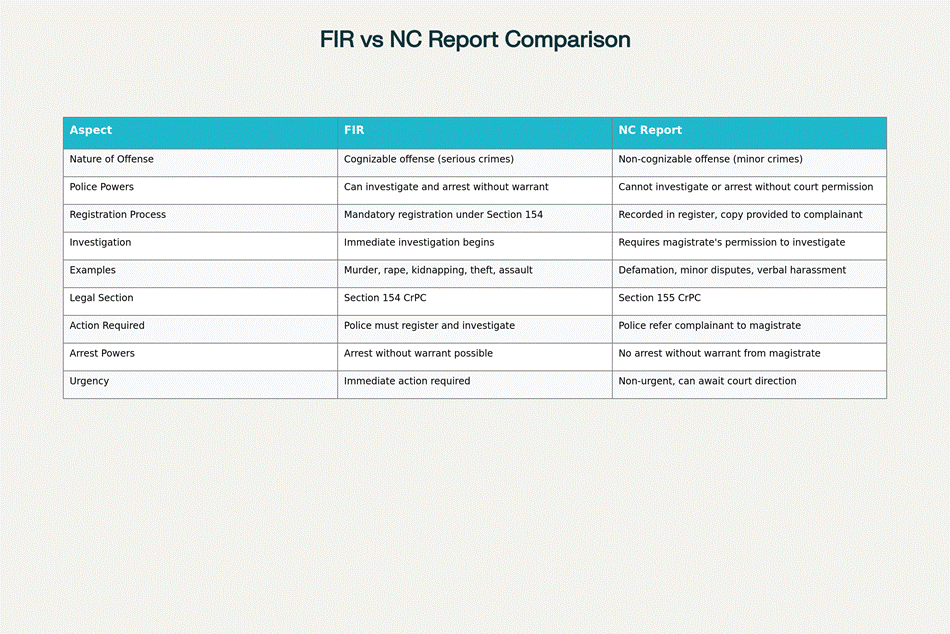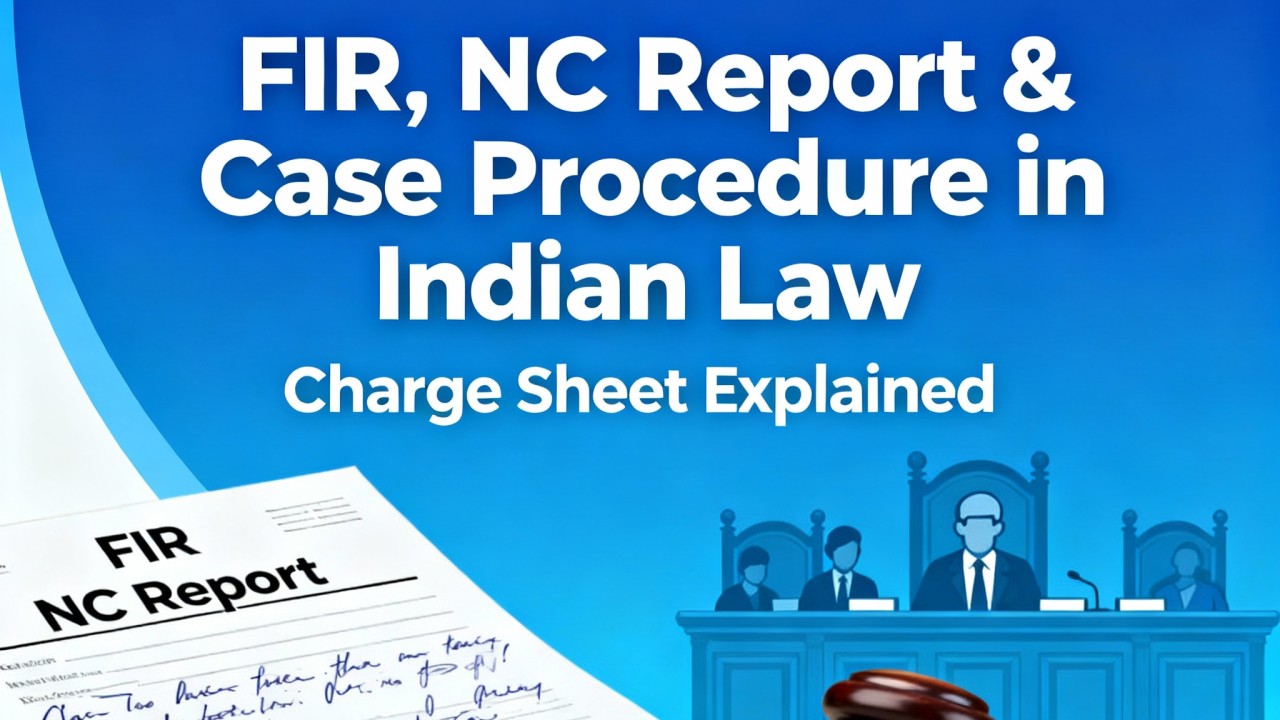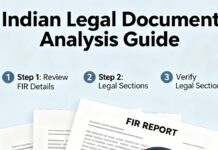Understanding Criminal Legal Documents: A Comprehensive Guide to FIR, NC Reports, Case Procedures, and Charge Sheets
This comprehensive guide examines the critical legal documents and procedures that form the backbone of India’s criminal justice system, providing essential knowledge for legal practitioners, accused persons, and anyone seeking to understand criminal legal processes. The following analysis draws from extensive legal provisions, judicial precedents, and practical procedures governing First Information Reports (FIRs), Non-Cognizable (NC) reports, case documentation, and charge sheets.

Comprehensive comparison between FIR and NC Report showing key legal and procedural differences
Reading and Understanding FIR and NC Reports
Structure and Format of First Information Reports
A First Information Report represents the foundational document in criminal proceedings, governed by Section 154 of the Code of Criminal Procedure, 1973. The FIR follows a standardized format across Indian states, though minor variations exist in specific formatting requirements. [1][2]
Essential Components of an FIR include:
The document begins with identifying information including district, police station, year, FIR number, and date of registration. The legal provisions section specifies the relevant acts and sections under which the offense is registered, typically including Indian Penal Code sections and other applicable statutes. Critical temporal information captures the occurrence details, including date and time of the offense, when information was received at the police station, and the General Diary reference entry. [2][1]
Personal Information Requirements:
The FIR must contain comprehensive complainant details including name, father’s or husband’s name, date of birth, nationality, passport information if applicable, occupation, and complete address. If the accused is known, similar identifying information must be recorded. The document must also explain any reasons for delay in reporting the offense. [1][2]
Narrative and Evidence Sections:
The core of the FIR contains the detailed narrative of events, description of properties stolen or involved with their estimated value, and any inquest report if applicable. The action taken section specifies the legal sections under which the case is registered, investigation assignments, and confirmation that the FIR was read to the complainant and a free copy provided. [2][1]
Understanding Non-Cognizable Reports
Non-Cognizable reports address less serious offenses where police cannot immediately arrest or investigate without magistrate’s permission. These reports are governed by Section 155 of the CrPC and handle matters such as defamation, minor disputes, verbal harassment, and public nuisances. [3][4][5]
Key Characteristics of NC Reports:
Unlike FIRs, NC reports are recorded in a separate register rather than the main FIR book. Police cannot initiate investigation or make arrests without specific court direction. The complainant receives a copy of the NC report, but further action requires approaching the magistrate under Section 200 CrPC. Common examples include simple assault without grievous hurt, verbal abuse and threats, minor property disputes, and defamation cases. [4][5][3]
Processing NC Reports:
When an NC complaint is filed, police record it in the Non-Cognizable Register and provide the complainant with a copy. Police typically advise the complainant to approach the magistrate for further legal action. The magistrate then determines whether the offense warrants investigation and can order police to investigate or handle the matter through civil remedies. [5][3]

Essential checklist for lawyers when consulting with accused clients covering all critical areas
Checklist of Questions When an Accused Approaches Legal Counsel
Initial Client Assessment and Documentation
When an accused person approaches legal counsel, systematic information gathering ensures comprehensive case preparation and effective defense strategy. The initial consultation forms the foundation for all subsequent legal proceedings and requires thorough documentation.[6]
Identity Verification and Preliminary Setup:
Legal practitioners must verify client identity through official documents such as identity cards, passports, or other government-issued identification. Establishing attorney-client privilege immediately protects all communications and ensures confidentiality throughout the legal process. The fee structure should be clarified and documented through a formal client-attorney agreement that outlines payment terms, scope of services, and professional responsibilities.[6]
Case Documentation and Evidence Gathering:
Obtaining copies of all relevant legal documents forms a critical early step, including the FIR, charge sheet, legal notices, court summons, and any previous case records. The lawyer must secure a detailed chronological account of events from the accused’s perspective, documenting timelines, locations, witnesses present, and the sequence of actions leading to the charges.[6]
Legal Position and Defense Assessment:
A comprehensive review of the client’s legal history includes any previous convictions, pending cases, or ongoing legal matters that might impact the current case. The assessment should evaluate potential defenses, alibi evidence, witness testimonies, and inconsistencies in the prosecution’s case that could strengthen the defense position.[6]
Rights Education and Strategic Planning
Fundamental Rights Protection:
Educating the accused about their constitutional and legal rights forms a cornerstone of effective legal representation. This includes the right to remain silent under Article 20(3) of the Constitution, protection from self-incrimination, right to legal representation, and proper procedures during police questioning.[7][8]
Bail and Custody Considerations:
Assessing bail eligibility requires examining the nature of charges, criminal history, flight risk factors, and likelihood of evidence tampering. The lawyer must evaluate whether the accused qualifies for regular bail, anticipatory bail, or statutory bail under various provisions of the CrPC.[6]
Evidence and Witness Strategy:
Identifying supporting evidence includes gathering documents, photographs, video recordings, electronic evidence, and physical evidence that supports the defense. Locating and interviewing potential defense witnesses, collecting alibi evidence, and documenting the accused’s whereabouts during the alleged crime time form essential defense preparation activities.[6]
Obtaining Copies of First Information Reports
Legal Framework and Procedures
The Supreme Court in Youth Bar Association of India v. Union of India (2016) established comprehensive guidelines for obtaining FIR copies, recognizing that accused persons have the right to receive FIR copies at an earlier stage than traditionally provided under Section 207 of the CrPC.[9][10]
Direct Application to Police:
Accused persons can submit applications through their lawyers to the concerned police officer or Superintendent of Police for certified FIR copies upon payment of prescribed fees. The police must provide the copy within 24 hours of receiving such applications. If the request is denied, the applicant can approach the Superintendent of Police, who must constitute a three-officer committee to address grievances within three days.[10][9]
Court-Based Applications:
When FIRs have been forwarded to magistrates or special judges, accused persons can apply directly to the concerned court for certified copies. Courts must provide these copies within two working days of application submission. This provision ensures access even when police are reluctant to provide copies directly.[9][10]
Online Access and Digital Provisions
Website Publication Requirements:
The Supreme Court mandated that FIR copies must be uploaded on police websites within 24 hours of registration, unless the case involves sensitive matters requiring confidentiality. Decisions about sensitivity can only be made by officers not below the rank of Deputy Superintendent of Police or equivalent grades.[9][10]
Sensitive Case Exceptions:
When FIRs are withheld due to sensitive nature, the affected person can file applications with appropriate courts for certified copies, which must be provided within three days. The definition of “sensitive” information remains within the discretion of appropriate authorities, but such decisions must be communicated to the concerned magistrate. [10][9]
Case Diary and General Diary: Usage and Distinctions
Case Diary: Investigation Documentation
Case Diary, governed by Section 172 of the CrPC, requires investigating officers to maintain daily records of investigation proceedings. This diary, also called “special diary,” “police diary,” or “Station House Report,” documents the investigative process chronologically.[11][12][13]
Mandatory Contents of Case Diary:
The investigating officer must record the time information reached them, investigation commencement and completion times, places visited during investigation, and circumstances ascertained through investigation. Additionally, witness statements recorded under Section 161 must be included, and the diary must be properly paginated and maintained as a bound volume.[12][11]
Legal Status and Accessibility:
Case diaries cannot be demanded by accused persons or their agents, nor can they inspect these documents as they are meant for court reference only. However, investigating officers may refer to case diaries to refresh memory during testimony, and courts may use them to contradict police officers if necessary. The diary assists magistrates in understanding the investigation’s day-to-day progress and methodologies employed.[13][11][12]
General Diary: Police Station Records
General Diary serves as a comprehensive record of all significant events and transactions within a police station’s jurisdiction over 24-hour periods. Governed by Section 44 of the Police Act, 1861, this document captures police personnel movements, responsibility transfers, arrests, law enforcement activities, and senior officer visits.[11][14]
Comprehensive Documentation Functions:
The General Diary records FIR registrations as significant police station events, with FIR summaries entered chronologically. Each day begins with entry number 1, creating parallel documentation where FIR references appear in General Diary entries and vice versa. This dual recording system ensures comprehensive record-keeping and administrative oversight. [14][11]
Administrative vs. Investigative Functions:
Unlike Case Diaries specific to particular investigations, General Diaries record all legal events within police station jurisdiction. The General Diary copy is forwarded to superior police officers for administrative oversight, but unlike Case Diaries, copies are not sent to judicial magistrates. Any person can lodge information for General Diary entry, not requiring victim status or eyewitness credentials. [11][14]
Understanding Cross FIRs
Definition and Legal Framework
Cross FIRs occur when two parties file separate First Information Reports regarding the same incident, with each party accusing the other of criminal conduct. This situation typically arises from mutual altercations, disputes, or conflicts where both parties claim victimization and seek legal redress. [15][16][17]
Legal Validity and Judicial Recognition:
The Supreme Court in T.T. Antony v. State of Kerala (2001) established that multiple FIRs for the same incident are generally impermissible unless they represent distinct versions by opposing parties. However, Cross FIRs are legally valid when they present counter-allegations arising from the same incident, ensuring both parties’ right to present their version of events. [16][17][18]
Common Scenarios for Cross FIRs:
Cross FIRs frequently occur in mutual physical altercations where both parties sustain injuries and file assault charges against each other. Property disputes often generate Cross FIRs when both parties allege trespass, theft, or damage by the other party. Domestic disputes, neighborhood conflicts, and business disagreements also commonly result in Cross FIR situations.[17][19][15]
Investigation and Trial Procedures
Separate Investigation Requirements:
Courts have mandated that Cross FIRs should be investigated by the same investigating officer to ensure consistency and prevent contradictory findings. Each FIR is treated as an independent complaint requiring thorough investigation of all allegations made by respective parties. The investigating officer must examine evidence supporting both versions and determine the factual accuracy of competing claims. [16][20][19][18]
Consolidated Trial Procedures:
When Cross FIRs involve the same incident and parties, courts may conduct consolidated trials to avoid contradictory judgments and ensure efficient judicial resource utilization. However, separate prosecutors must represent each case to maintain legal propriety and avoid conflicts of interest. The court must carefully evaluate evidence from both cases to determine the actual sequence of events and assign appropriate liability. [19][18][16]

Comprehensive structure of a charge sheet showing all mandatory components under Section 173 CrPC
Understanding Charge Sheets
Legal Foundation and Purpose
A charge sheet represents the culmination of police investigation and the formal transition from investigative to prosecutorial phases of criminal proceedings. Governed by Section 173(2) of the CrPC, it serves as the police’s final report to the magistrate, containing comprehensive details of investigation findings and recommendations for prosecution.[21][22][23]
Mandatory Components Under Section 173(2):
Every charge sheet must contain the names of all parties involved, including complainant, accused, and relevant witnesses. The nature of information received and detailed description of the alleged offence must be clearly stated. The document must identify persons acquainted with case circumstances and specify whether any offence appears committed and by whom.[22][24][21]
Investigation and Custody Details:
The charge sheet must specify whether accused persons were arrested, their release status with or without sureties, and whether they were forwarded to custody under Section 170. Medical reports must be attached for certain categories of offences, and all supporting documents collected during investigation must accompany the charge sheet.[25][21][22]
Filing Requirements and Procedures
Completion of Investigation Prerequisite:
The Supreme Court in Ritu Chhabaria v. Union of India (2023) emphasized that charge sheets cannot be filed without completing investigation, as premature filing would deprive accused persons of their right to default bail under Section 167(2) CrPC. Investigation completion ensures all evidence has been gathered, witness statements recorded, and forensic examinations completed.[22][23][26]
Submission and Cognizance Process:
After completing investigation, the charge sheet is forwarded to the magistrate empowered to take cognizance of the alleged offence. The magistrate examines the charge sheet and supporting materials to determine whether prima facie evidence exists to proceed with prosecution. This judicial scrutiny ensures that only cases with sufficient evidence proceed to trial.[24][27][22]
Evidentiary Value and Limitations
Non-Substantive Nature of Charge Sheets:
Like FIRs, charge sheets do not constitute substantive evidence in criminal trials but represent the investigating officer’s opinion based on collected evidence. The contents must be proved independently during trial through witness examination and documentary evidence presentation. Charge sheets serve as formal accusations guiding prosecution strategy rather than conclusive proof of guilt.[22][28][27]
Supplementary Charge Sheets:
Under Section 173(8) CrPC, investigating officers may submit supplementary charge sheets when additional evidence emerges after filing the original charge sheet. This provision ensures that investigation can continue even after formal prosecution begins, allowing for comprehensive evidence presentation while maintaining procedural integrity.[28][23][22]
Practical Applications and Professional Considerations
For Legal Practitioners
Understanding these documents enables effective case preparation, client counseling, and strategic planning throughout criminal proceedings. Practitioners must master document interpretation to identify procedural irregularities, evidentiary gaps, and defense opportunities. Proper documentation review forms the foundation for bail applications, discharge petitions, and trial preparation.
For Accused Persons
Knowledge of these procedures empowers accused persons to understand their legal position, exercise constitutional rights effectively, and make informed decisions about legal representation. Understanding documentation requirements helps in gathering supporting evidence and preparing comprehensive defense strategies.
For the Justice System
Proper documentation and procedural compliance ensure fair trials, protect constitutional rights, and maintain public confidence in the criminal justice system. These procedures balance investigative efficiency with individual rights protection, creating a framework for just and transparent legal proceedings.
The intricate web of criminal legal documentation serves as the foundation upon which India’s criminal justice system operates, ensuring that constitutional protections, procedural fairness, and legal accountability remain paramount throughout the investigation and prosecution process. Mastery of these concepts enables effective participation in the criminal justice system while safeguarding the rights and interests of all stakeholders involved in criminal proceedings.
- https://egyankosh.ac.in/bitstream/123456789/39098/1/Unit-2.pdf
- https://www.drishtijudiciary.com/to-the-point/bharatiya-nagarik-suraksha-sanhita-&-code-of-criminal-procedure/first-information-report-fir
- https://lawrato.com/criminal-legal-advice/regarding-arrest-on-nc-filed-by-3-different-peoples-on-one-person-nc-full-form-in-police-242260
- https://www.newsband.in/article_detail/common-mans-guide-to-firs-and-ncs
- https://restthecase.com/knowledge-bank/what-is-ncr-in-police-station
- https://www.scribd.com/document/877740708/SKILL-2-Checklist-of-Questionnaire-When-an-Accused-Approaches-You
- https://liberal-international.org/what-we-do/events/executive-committee-meetings/marrakech-2016/10-basic-rights-accused-persons-criminal-proceedings-marrakech-2016/
- https://www.mondaq.com/india/crime/1255970/rights-of-the-accused-before-or-after-arrest-in-india
- https://orissajudicialacademy.nic.in/monthly_case_review/aprr.pdf
- https://gyansanchay.csjmu.ac.in/wp-content/uploads/2022/09/pre-trial-procedure-FIR.pdf
- https://www.scribd.com/document/730486550/Police-Diary-and-General-Diary
- https://vidhijudicial.com/police-diary-section-172-criminal-procedure-code.html
- https://anandduggal.com/rti-police-diary-disclosure.html
- https://gokulamseekias.com/prelims-c-a/polity/fir-and-general-diary/
- https://www.lawasitis.com/supreme-court-guidelines-on-cross-cases-fir/
- https://blog.ipleaders.in/scope-second-fir-open-question-indian-criminal-system/
- https://www.ipandlegalfilings.com/jurisprudence-of-cross-firs/
- https://www.ilms.academy/blog/understanding-fir-cross-fir-and-zero-fir-in-the-indian-legal-system
- https://kaleandshinde.com/blog/fir-clubbing-streamlining-justice-or-overstepping-bounds
- https://www.metalegal.in/post/clubbing-of-investigations-and-trials
- https://www.drishtijudiciary.com/current-affairs/chargesheet
- https://lawbhoomi.com/the-charge-sheet/
- https://blog.ipleaders.in/all-about-section-173-crpc/
- https://restthecase.com/knowledge-bank/what-happens-after-a-chargesheet-is-filed-in-court
- https://courseware.cutm.ac.in/wp-content/uploads/2020/06/Role-of-Charge-Sheet.pdf
- https://blog.ipleaders.in/all-about-a-chargesheet/
- https://www.iilsindia.com/blogs/relevance-charge-sheet-code-criminal-procedure/
- https://blog.ipleaders.in/difference-between-charge-sheet-and-fir/
- https://advocaterajeyjain.com/fir-and-nc.php
- https://blog.ipleaders.in/first-information-report-everything-important-you-should-know-about/
- https://www.humanrightsinitiative.org/publications/police/fir.pdf
- https://www.bryanhoellerlaw.com/checklist-were-your-rights-violated-arrest/
- https://www.drishtiias.com/daily-updates/daily-news-analysis/fir-and-general-diary
- https://kishanganj.nic.in/faq/f-i-r-n-c-complaint-cognizance/
- https://worldjusticeproject.org/sites/default/files/documents/PJSI – Human Rights Checklists.pdf
- https://www.indialawoffices.com/legal-articles/first-information-report-fir
- https://bprd.nic.in/page/citizen_corner
- https://cjp.org.in/law-on-arrest-and-detention-know-your-rights/
- https://legalwellbeing.in/fir-first-information-report/
- https://citizen.mahapolice.gov.in/Citizen/mh/faq.aspx
- https://restthecase.com/knowledge-bank/crpc/section-154
- https://devgan.in/crpc/section/154/
- https://blog.ipleaders.in/all-you-need-to-know-about-section-154-of-crpc/
- https://devgan.in/crpc/chapter_12.php
- https://www.iasgyan.in/daily-current-affairs/general-diary-and-fir
- https://www.indiacode.nic.in/show-data?actid=AC_CEN_5_23_000010_197402_1517807320555&orderno=176
- https://blog.ipleaders.in/case-diary-cr-p-c/
- https://www.youtube.com/watch?v=_Uo5a5QvvnM
- https://www.scribd.com/document/496134702/100008495
- https://www.scribd.com/document/506577262/Final-Report-Crpc
- https://www.lawteacher.net/free-law-essays/administrative-law/concept-of-a-police-report-administrative-law-essay.php
- https://www.vidhikarya.com/FreeLegalAdvice/4538/chargesheet-and-final-report
- https://restthecase.com/knowledge-bank/police-chargesheet-procedure
- https://tilakmarg.com/forum/topic/difference-between-police-report-or-final-report-and-charge-sheet/
- https://police.py.gov.in/Police manual/Forms pdf/FORM- IF5.pdf
- https://webapi.sci.gov.in/supremecourt/2017/3873/3873_2017_2_1501_52782_Judgement_01-May-2024.pdf
- https://devgan.in/crpc/section/173/
- https://www.drishtijudiciary.com/to-the-point/bharatiya-nagarik-suraksha-sanhita-&-code-of-criminal-procedure/chargesheet
- https://police.py.gov.in/GO. Ms. No. 42 – Police Report – Annexure.pdf
















